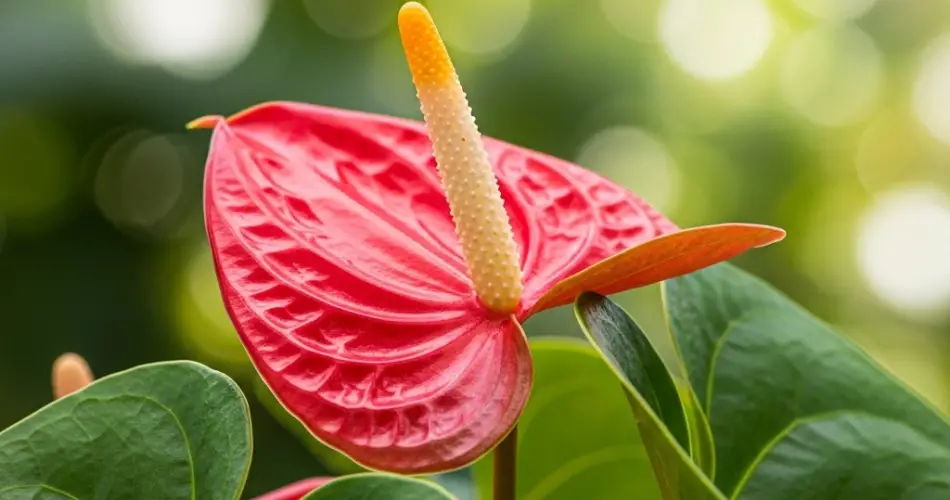Anthuriums, also known as flamingo flowers or laceleaf, are popular for their exotic, long-lasting blooms and glossy foliage. However, if your plant is growing well but not producing flowers, there could be several reasons behind the issue. Luckily, most flowering problems in anthuriums are easily fixed with a few adjustments to care and environment. Here’s a breakdown of why your anthurium may not be flowering—and how to encourage it to bloom again.
1. Insufficient Light
One of the most common reasons anthuriums stop blooming is lack of adequate light. Anthuriums are tropical plants that prefer bright, indirect light. While they can survive in low light, they won’t produce flowers under those conditions. Direct sunlight, on the other hand, can scorch the leaves.
Solution: Move your anthurium to a spot where it receives bright but filtered light—such as near an east or north-facing window. If growing indoors in a dim area, consider supplementing with a grow light for a few hours each day.
2. Overwatering or Poor Drainage
Too much water or soggy soil can prevent flowering and lead to root rot. Anthuriums like moist but not waterlogged soil. When the roots are constantly sitting in wet soil, the plant becomes stressed and won’t have the energy to produce flowers.
Solution: Allow the top inch of soil to dry out before watering again. Use a well-draining potting mix—ideally one formulated for orchids or a mix of peat, perlite, and pine bark. Ensure the pot has drainage holes and never let it sit in standing water.
3. Lack of Nutrients
Plants need energy to flower, and that energy comes from nutrients in the soil. If your anthurium hasn’t bloomed in months and has pale or yellowing leaves, it may be lacking key nutrients—especially phosphorus, which promotes blooming.
Solution: Feed your plant with a balanced, water-soluble fertilizer every 6–8 weeks during the growing season (spring and summer). A fertilizer with a higher middle number (e.g., 10-30-20) can support flower production. Be careful not to over-fertilize, which can burn roots and harm the plant.
4. Incorrect Temperature or Humidity
Anthuriums thrive in warm, humid conditions. Temperatures that are too cold or inconsistent can prevent flowering. Likewise, very dry air—common indoors with heating or air conditioning—can cause the plant to stop blooming.
Solution: Keep your anthurium in a room with temperatures between 65–80°F (18–27°C). Avoid placing it near drafts, vents, or cold windows. Increase humidity by using a pebble tray with water, misting the leaves, or placing a humidifier nearby.
5. Old or Tired Plant
If your anthurium is several years old and hasn’t been repotted or pruned, it may need some rejuvenation. Over time, the soil loses nutrients, and the plant can become root-bound or leggy, which reduces its ability to bloom.
Solution: Repot the plant every 2–3 years in fresh potting mix to replenish nutrients and encourage healthy growth. Remove any dead or yellowing leaves, and trim back leggy stems to redirect energy to new growth and potential blooms.
6. Improper Pruning
Dead or faded flowers left on the plant can delay new blooming. This is because the plant continues to send energy to old flowers instead of focusing on producing new ones.
Solution: Regularly deadhead old blooms by snipping them off near the base of the stem. This helps the plant redirect its resources to new flower development.
7. Stress from Relocation or Changes
If you’ve recently moved your plant or changed its growing environment (like lighting or watering schedule), it may temporarily stop blooming due to stress. Even small changes can affect flowering.
Solution: Be patient and give the plant time to adjust. Continue providing consistent care, and avoid moving it unless necessary. Once it adapts, blooming may resume.
Final Thoughts
Anthuriums are not the easiest flowering houseplants, but with the right care, they will reward you with bold, beautiful blooms year-round. Focus on providing consistent warmth, humidity, indirect light, and a balanced feeding routine. Keep the roots healthy and avoid letting the soil become waterlogged. With a little attention and patience, your anthurium will return to its flowering glory in no time.



